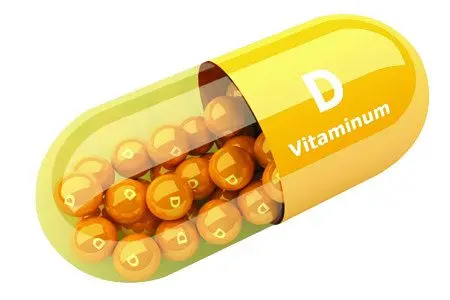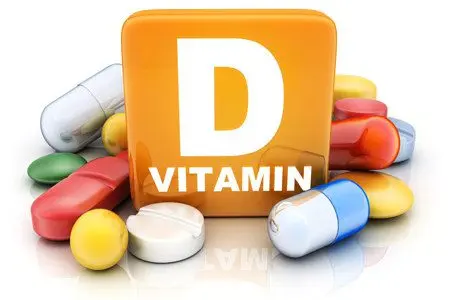Contents


Vitamin D (cholecalciferol) is a fat-soluble vitamin that is essential for the full absorption of calcium, without which mineralization and bone growth is not possible. Vitamin D is involved in the immune system, digestive, nervous, hematopoietic systems. Recent work by scientists has proven that it has a preventive effect on heart pathologies, diabetes, oncological pathologies, and depression.
The main feature of colcalciferol is its hormonal rather than vitamin action. It has a corrective effect on almost 200 genes. Almost half of people are found to be deficient in vitamin D.
List of the best foods with vitamin D
What foods contain the most vitamin D? In nature, it is not common, the champions are fatty varieties of fish, such as mackerel, tuna, halibut, salmon, trout, cod (including canned food from these fish).
In addition to fatty fish, look out for canned sardines (100 grams of sardines in oil will satisfy 33%), chicken eggs (2 eggs satisfy 17%), and goat milk (a glass of milk will satisfy 17% of the daily requirement of 600 IU) .
 1 tablespoon (15 ml) 1360 IU (34 mcg)
1 tablespoon (15 ml) 1360 IU (34 mcg) Maitake: 1124 IU (28,1 mcg) Chanterelles: 212 IU (5,3 mcg) Morels: 204 IU (5,1 mcg)
Maitake: 1124 IU (28,1 mcg) Chanterelles: 212 IU (5,3 mcg) Morels: 204 IU (5,1 mcg) Mackerel: 1008 IU (25,2 mcg) Carp: 988 IU (24,7 mcg) Sockeye: 668 IU (16,7 mcg) Chub: 520 IU (13 mcg) Catfish: 500 IU (12,5 mcg) Herring: 216 IU (5,4 mcg)
Mackerel: 1008 IU (25,2 mcg) Carp: 988 IU (24,7 mcg) Sockeye: 668 IU (16,7 mcg) Chub: 520 IU (13 mcg) Catfish: 500 IU (12,5 mcg) Herring: 216 IU (5,4 mcg) 484 ME (12,1 mcg)
484 ME (12,1 mcg) 100 g: 216 IU (5,4 mcg) 1 yolk: 52 IU (1,3 mcg)
100 g: 216 IU (5,4 mcg) 1 yolk: 52 IU (1,3 mcg) Canned: 192 IU (4,8 mcg)
Canned: 192 IU (4,8 mcg) 124 ME (3,1 mcg)
124 ME (3,1 mcg) 96 ME (2,4 mcg)
96 ME (2,4 mcg) 52 ME (1,3 mcg)
52 ME (1,3 mcg) 52 ME (1,3 mcg)
52 ME (1,3 mcg)View the entire table 200+ ➤
Vegetables and fruits-record holders for the content of vitamin D
* Please note that except for some mushrooms, all types of vegetables and fruits do not contain vitamin D, from the word, at all.
maitake mushrooms | 28,1 μg |
Chanterelles | 5,3 μg |
morel mushrooms | 5,1 μg |
Champignon | 0,2 μg |
How much vitamin D should children, adults and pregnant women take per day?
Age | Mkg | ME/IU | Maximum |
0-6 months | 8,5-10 | 400 | 25 mcg (1000 IU) |
7-12 months | 10 | 400 | 37,5 mcg (1500 IU) |
1-3 years | 15 | 600 | 62,5 mcg (2500 IU) |
4-8 years | 15 | 600 | 75 mcg (3000 IU) |
9-69 years | 15 | 600 | 100 mcg (4000 IU) |
Older than 70 years | 20 | 800 | 100 mcg (4000 IU) |
Pregnant and lactating | 15 | 600 | 100 mcg (4000 IU) |
American Society of Endocrinology Guidelines (2011)
*1000 international units (IU) of vitamin D is 25 mcg = 0,025 mg = 1000 IU.
In accordance with the recommendations of the European Committee on Food Safety, the age-specific daily intake of vitamin D has been established:
children from 6 to 11 months – 400 IU (10 mcg);
from 1 year and adults – 600 IU (15 mcg).
When should you take more vitamin D?
Certain categories of people need higher doses of the vitamin:
living in the northern regions (where there is very little sun);
living in places with unfavorable environmental conditions;
who work at night;
people with dark skin color (the darker it is, the more time it takes for the sun to penetrate it);
bedridden patients, or simply not going out (going out extremely rarely) on the street;
suffering from pathologies of the gastrointestinal tract, in which there is a reduced absorption of vitamin D;
people with a large amount of subcutaneous fat (which interferes with full absorption);
pregnant and lactating mothers;
the elderly (especially those with frequent colds);
people with a genetic polymorphism of the vitamin D receptor, due to which this vitamin is simply not absorbed (some do not even suspect that they have it);
during an infectious disease (viruses always tend to block receptors for the absorption of vitamin D, which is very necessary for leukocytes, our “defenders” from viruses);
metabolic diseases, such as arthritis, diabetes, hypertension and cardiovascular pathologies, significantly increase the need.
The maximum single dose of vitamin D is 100000 IU. Dosage is allowed only with the appointment of a doctor according to indications.
Vitamin D1, D2, D3, D4, D5, D6 – what’s the difference?
The definition of “vitamin D” can mean several vitamins – D1, D2, D3, D4, D5, D6. For the human body, two forms are of particular value – D2, D3. A detailed study of each of the compounds showed a number of features:
D1 – consists of lumisterol and ergocalciferol, synthesized only artificially. In therapeutic practice is not used.
D2 Ergocalciferol is found in plant products. It does not significantly affect the level of calciferol in the blood.
D3 – cholecalciferol – enters the body with animal products, is able to be synthesized in the layers of the skin under the influence of sunlight. It is the most active form of all the D vitamins.
D4 – is deposited in the layers of the epidermis, under the influence of sunlight it is converted into an active D3-form;
D5 – an artificially synthesized form of D3, developed for the treatment of oncological pathologies.
D6 – the “youngest” form of the vitamin, obtained from plants. Currently, laboratory experiments on its application are underway.

What is vitamin D for?
Long-term medical observations have established that vitamin D has a lot of positive effects on the human body:
ensures adequate tooth formation and bone growth in infants and young children;
contributes to the preservation of the integrity of the teeth, the skeletal system;
participates in the formation of the protective properties of the body;
reduces the likelihood of fractures;
helps to fully absorb phosphorus, calcium and maintain a normal level of the latter in the blood;
provides physiological cell division.
Application in medicine

Osteoporosis. The presence of vitamin D ensures the absorption of calcium by the intestinal mucosa. Helps to maintain optimal levels of phosphorus and calcium, which ensures sufficient bone mineralization. Without colcalciferol, bone growth and restoration of bone tissue by osteoblasts and osteoclasts is impossible. Vitamin D deficiency can cause brittle and deformed bones. The intake of a sufficient amount of a vitamin compound prevents rickets in childhood, osteomalacia in older people. The combined action of colcalciferol and calcium prevents the development of osteoporosis [1].
Softening of the bones. Osteomalacia, which has developed regardless of causative factors, can be treated with vitamin D. It allows you to eliminate side, softening bones, defects from treatment with certain pharmaceuticals.
Rickets. Vitamin D preparations are prescribed for the treatment and prevention of rickets.
Psoriasis. In some forms of psoriasis, a positive effect is observed with the combined external use of vitamin D preparations with corticosteroids.
Oncological diseases. The results of the use of vitamin D in relation to patients with malignant tumors showed that the drug is able to prevent the development of colorectal cancer by 30%. Women who take vitamin D supplements are less likely to get breast cancer over 20 years [2].
Type 1 diabetes, multiple sclerosis, rheumatoid arthritis. Medical observations have shown that vitamin D reduces the likelihood of developing autoimmune processes. Vitamin compound forms protective reactions so that the autoimmune effect is weakened [3].
Tuberculosis. Vitamin D deficiency increases the risk of developing tuberculosis. Its presence in the protocols for the treatment of tuberculosis has a pronounced therapeutic effect. [4], [5].
Renal osteodystrophy. Patients with kidney failure take vitamin D supplements to reduce calcium leaching from bones [6].
Prevention of colds, bronchitis and pneumonia. Vitamin D ensures the functionality of the immune system, resists viruses, pathogenic bacteria. The beneficial effect of calciferol on specific cells of the body protects it from infectious diseases. The protective factors of the vitamin preparation are similar in effectiveness to the effect of the flu and SARS vaccine [7].
Lowers blood pressure. Vitamin D inhibits the production of renin, which has a hypertensive effect. Regular doses of the vitamin help maintain normal blood pressure levels. [8].
When curing blood vessels.. Hardening of blood vessels as a result of calcification is a dangerous symptom of many serious heart diseases. And vitamin D deficiency correlates with this symptom. Thus, the Medical Institute of Georgia in the USA, noticed that increasing the dosage from the recommended 600 IU to 4000 IU per day reduces calcification by 10,4% in 4 months. [9].
The effectiveness of taking vitamin D

The effect of taking vitamin D can be seen from the results of studies in which the concentration of the drug in the blood reached 125 nmol / l:
Rickets — at 100%.
Bone softening – 100%.
Oncological diseases – 75%.
Breast cancer in women – by 50%.
Ovarian cancer – by 25%.
Uterine cancer – 35%.
Colorectal cancer — 65%.
Kidney cancer – 65%.
Type 2 diabetes — 50%.
Traumatic bone injuries – 50%.
Multiple sclerosis – by 50%.
Heart attack — 50%.
Vascular pathologies – 80%.
Preeclampsia of pregnant women – by 50%.
Caesarean section – 75%.
Problems with conception – 70%.
Application in sports
Impact on strength and power vitamin D was proven in 2013. During the experiments, it was found that they are able to influence the strength of muscle contractions, increase the volume and quality of muscle fibers. It should be noted that the reason for prescribing vitamin D to athletes is its lack in the blood. [10].
Testosterone boost depends on the level of vitamin D in the body. The drugs are additionally prescribed to men with an established vitamin deficiency at a level of less than 75 nmol / l. In the course of studies, it was found that the administration of vitamin D at a dosage of 3330 IU to overweight men stimulated the synthesis of testosterone by 25% [11].
Vitamin D is not considered doping, since at normal levels in the blood it does not have a stimulating effect on the body. Abuse of drugs with its content can provoke the development of conditions dangerous to health.
[Video] Vitamin D or D hormone – FreshLife28 channel
Drug Interactions
Vitamin D reduces the activity of cardiac glycosides.
When treated with corticosteroids, vitamin D is more rapidly excreted, and calcium absorption is impaired.
Difenin, barbiturates – prevent the absorption of vitamin D, against which adults may develop signs of rickets, osteomalacia.
Cortisone, antacids inhibit the absorption of vitamin D.
Cholesterol-lowering drugs interfere with the absorption of fats and fat-soluble vitamins.
Anti-tuberculosis drugs negatively affect the metabolism of vitamin D, calcium and phosphorus.
Vitamin D can cause iron levels to drop.
Vitamin E deficiency prevents the liver from properly absorbing vitamin D.









